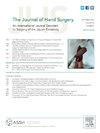The Contribution of the Distal Oblique Band to Distal Radioulnar Joint Stability
IF 2.1
2区 医学
Q2 ORTHOPEDICS
引用次数: 0
Abstract
Purpose
The distal radioulnar joint (DRUJ) is supported by an array of dynamic and static stabilizers, of which the triangular fibrocartilage complex (TFCC) is the most important, and the distal interosseous ligament is next in importance. The distal oblique band (DOB) is an identifiable component of the distal interosseous ligament, found in a subset of the population. Our objective was to determine the contribution of the DOB to DRUJ stability in the presence of a disrupted TFCC.
Methods
Twenty-three above-elbow specimens were prepared by removing the TFCC and the DRUJ joint capsule, preserving the distal interosseous ligament and the pronator quadratus. Cadavers were stratified into two groups—those with, and those without a DOB. A bone plate and screws were attached to the ulna; then, a transverse load was applied to failure, creating a diastasis between the radius and ulna.
Results
The group with a DOB had a mean load at failure of 160.7 ± 46.5 N. The group without a DOB had a mean load at failure of 148.0 ± 26.3 N. Stiffness prior to failure was 16.9 N/mm in the group with a DOB and 12.4 N/mm in the group without a DOB.
Conclusions
The current results indicate that the DOB may not substantially contribute to DRUJ stability in the presence of a disrupted TFCC.
Clinical relevance
Stability of the DRUJ after TFCC injury may not be substantially improved by the presence of a DOB. Thus, the clinical importance of DOB reconstruction remains unclear.
远端斜带对桡骨远端关节稳定性的贡献
目的远端尺桡关节(DRUJ)是由一系列动态和静态稳定器支撑的,其中三角纤维软骨复合体(TFCC)是最重要的,其次是远端骨间韧带。远端斜束(DOB)是远端骨间韧带的一个可识别的组成部分,在人群的一个子集中发现。我们的目的是确定在TFCC中断的情况下DOB对DRUJ稳定性的贡献。方法切除TFCC和DRUJ关节囊,保留远端骨间韧带和旋前方肌,制备肘部以上标本23例。尸体被分为两组,一组有死亡时间,另一组没有。将骨板和螺钉固定在尺骨上;然后,横向载荷被施加到失败,造成桡骨和尺骨之间的分离。结果有DOB组失效时平均载荷为160.7±46.5 N,无DOB组失效时平均载荷为148.0±26.3 N,失效前刚度有DOB组为16.9 N/mm,无DOB组为12.4 N/mm。结论目前的结果表明,在TFCC被破坏的情况下,DOB可能对DRUJ的稳定性没有实质性的贡献。TFCC损伤后DRUJ的临床相关性可能不会因DOB的存在而得到实质性改善。因此,DOB重建的临床重要性尚不清楚。
本文章由计算机程序翻译,如有差异,请以英文原文为准。
求助全文
约1分钟内获得全文
求助全文
来源期刊
CiteScore
3.20
自引率
10.50%
发文量
402
审稿时长
12 weeks
期刊介绍:
The Journal of Hand Surgery publishes original, peer-reviewed articles related to the pathophysiology, diagnosis, and treatment of diseases and conditions of the upper extremity; these include both clinical and basic science studies, along with case reports. Special features include Review Articles (including Current Concepts and The Hand Surgery Landscape), Reviews of Books and Media, and Letters to the Editor.

 求助内容:
求助内容: 应助结果提醒方式:
应助结果提醒方式:


